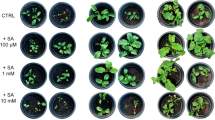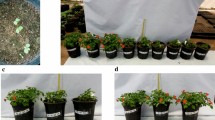Abstract
We have demonstrated that applications of low concentrations of salicylic acid (SA) to the shoots of seedlings of plants or to perennial trees significantly increase their growth, development, and productivity. It is proposed that the positive effect of the SA of increasing the size of the roots favours the absorption and accumulation of macro and micronutrients and contribute to biomass and seed production. To test this hypothesis, we run experiments on Zea mays, Capsicum chinense and Solanum lycopersicum and measure their nutritional absorption after spraying, low concentrations (SA) to the canopy. The results have shown that (SA) significantly increases the length, weight and dry weight of roots, stems, leaves and yield of these species, as well as the levels of nitrogen (N), phosphorus (P) and potassium (K) in the different organs of the plants at the time of harvest. Copper, zinc, manganese, iron, boron, calcium, and magnesium were also increased in most tissues by the effect of SA.
Access this chapter
Tax calculation will be finalised at checkout
Purchases are for personal use only
Similar content being viewed by others
References
Arfan, M., Athar, H. R., & Ashraf, M. (2007). Does exogenous application of salicylic acid through the rooting medium modulate growth and photosynthetic capacity in two differently adapted spring wheat cultivars under salt stress? Journal of Plant Physiology, 164(6), 685–694.
Asghari, M., & Aghdam, M. S. (2010). Impact of salicylic acid on post-harvest physiology of horticultural crops. Trends in Food Science & Technology, 21(10), 502–509.
Babalar, M., Asghari, M., Talaei, A., & Khosroshahi, A. (2007). Effect of pre-and postharvest salicylic acid treatment on ethylene production, fungal decay and overall quality of Selva strawberry fruit. Food Chemistry, 105(2), 449–453.
Echevarría-Machado, I., Escobedo-GM, R. M., & Larqué-Saavedra, A. (2007). Responses of transformed Catharanthus roseus roots to femtomolar concentrations of salicylic acid. Plant Physiology and Biochemistry, 45(6–7), 501–507.
El Tayeb, M. A., & Ahmed, N. L. (2010). Response of wheat cultivars to drought and salicylic acid. American-Eurasian Journal of Agronomy, 3(1), 01–07.
Elwan, M. W. M., & El-Hamahmy, M. A. M. (2009). Improved productivity and quality associated with salicylic acid application in greenhouse pepper. Scientia Horticulturae, 122(4), 521–526.
Fahad, S., & Bano, A. (2012). Effect of salicylic acid on physiological and biochemical characterization of maize grown in saline area. Pakistan Journal of Botany, 44(4), 1433–1438.
Farouk, S., Arafa, S. A., & Nassar, R. M. (2018). Improving drought tolerance in corn (Zea mays L.) by foliar application with salicylic acid. International Journal of Environment, 7(3), 104–123.
Ghazi, D. (2017). Impact of drought stress on maize (Zea mays) plant in presence or absence of salicylic acid spraying. Journal of Soil Sciences and Agricultural Engineering, 8(6), 223–229.
Gunes, A., Inal, A., Alpaslan, M., Eraslan, F., Bagci, E. G., & Cicek, N. (2007). Salicylic acid induced changes on some physiological parameters symptomatic for oxidative stress and mineral nutrition in maize (Zea mays L.) grown under salinity. Journal of Plant Physiology, 164(6), 728–736.
Gutiérrez-Coronado, M. A., Trejo-López, C., & Larqué-Saavedra, A. (1998). Effects of salicylic acid on the growth of roots and shoots in soybean. Plant Physiology and Biochemistry, 36(8), 563–565.
Hayat, S., Ali, B., & Ahmad, A. (2007). Salicylic acid: Biosynthesis, metabolism and physiological role in plants. In Salicylic acid: A plant hormone (pp. 1–14). Springer.
Janda, K., Hideg, É., Szalai, G., Kovács, L., & Janda, T. (2012). Salicylic acid may indirectly influence the photosynthetic electron transport. Journal of Plant Physiology, 169(10), 971–978.
Javaheri, M., Mashayekhi, K., Dadkhah, A., & Tavallaee, F. Z. (2012). Effects of salicylic acid on yield and quality characters of tomato fruit (Lycopersicum esculentum Mill.). International Journal of Agriculture and Crop Sciences (IJACS), 4(16), 1184–1187.
Karlidag, H., Yildirim, E., & Turan, M. (2009). Exogenous applications of salicylic acid affect quality and yield of strawberry grown under antifrost heated greenhouse conditions. Journal of Plant Nutrition and Soil Science, 172(2), 270–276.
Keshavarz, Y., Alizadeh, O., Sharfzade, S., Zare, M., & Bazrafshan, F. (2019). Investigating the importance of salicylic acid and mycorrhiza in reducing the unfavorable effects of Stre sses on maize. Journal of Materials and Environmental Sciences, 5(12), 1401–1412.
Khan, M. I. R., Iqbal, N., Masood, A., Per, T. S., & Khan, N. A. (2013). Salicylic acid alleviates adverse effects of heat stress on photosynthesis through changes in proline production and ethylene formation. Plant Signaling & Behavior, 8(11), e26374.
Khodary, S. E. A. (2004). Effect of salicylic acid on the growth, photosynthesis and carbohydrate metabolism in salt stressed maize plants. International Journal of Agriculture and Biology, 6(1), 5–8.
Larqué-Saavedra, A., & Martin-Mex, R. (2007). Effects of salicylic acid on the bioproductivity of plants. In Salicylic acid: A plant hormone (pp. 15–23). Springer.
Larqué-Saavedra, A., Martín-Mex, R., Nexticapan-Garcéz, Á., Vergara-Yoisura, S., & Gutiérrez-Rendón, M. (2010). Efecto del ácido salicílico en el crecimiento de plántulas de tomate (Lycopersicon esculentum Mill.). Revista Chapingo. Serie horticultura, 16(3), 183–187.
López, T. R., Camacho, R. V., & Gutiérrez, C. M. A. (1998). Aplicación de ácido salicílico para incrementar el rendimiento agronómico en tres variedades de trigo. Terra Latinoamericana, 16, 43–48.
Lu, X., Sun, D., Li, Y., Shi, W., & Sun, G. (2011). Pre-and post-harvest salicylic acid treatments alleviate internal browning and maintain quality of winter pineapple fruit. Scientia Horticulturae, 130(1), 97–101.
Martín-Mex, R., López-Gutiérrez, R., Medina-Arceo, J., Cruz-Campos, J., Nexticapan-Garces, A., González-Rodríguez, F., & Larqué-Saavedra, A. (2004). Incremento en la productividad de chile habanero (Capsicum chinense Jacq.) por aspersiones de ácido salicílico. In Primera Convención Mundial del chile. León, Guanajuato, México (p. 326).
Martín-Mex, R., Nexticapan-Garcés, A., Vega-Merino, L., Baak-Polanco, A., & Larqué-Saavedra, A. (2005). Efecto del ácido salicílico en la floración y productividad de chile habanero (Capsicum chinense Jacq.). In Segunda Convención Mundial del chile. Zacatecas, Zacatecas, México (pp. 325–326).
Martín-Mex, R., Vergara-Yoisura, S., Nexticapán-Garcés, A., & Larqué-Saavedra, A. (2010). Application of low concentrations of salicilyc acid increases the number of flowers in Petunia hibrida. Agrociencia, 44(7), 773–778.
Martin-Mex, R., Nexticapan-Garcéz, Á., Herrera-Tuz, R., Vergara-Yoisura, S., & Larqué-Saavedra, A. (2012). Efecto positivo de aplicaciones de ácido salicílico en la productividad de papaya (Carica papaya). Revista mexicana de ciencias agrícolas, 3(8), 1637–1643.
Martín-Mex, R., Nexticapan-Garcéz, A., & Larqué-Saavedra, A. (2013). Potential benefits of salicylic acid in food production. In Salicylic acid (pp. 299–313). Springer.
Sánchez-Chávez, E., Barrera-Tovar, R., Muñoz-Márquez, E., Ojeda-Barrios, D. L., & Anchondo-Nájera, Á. (2011). Efecto del ácido salicílico sobre biomasa, actividad fotosintética, contenido nutricional y productividad del chile jalapeño. Revista Chapingo. Serie horticultura, 17(SPE1), 63–68.
San-Miguel, R., Gutiérrez, M., & Larqué-Saavedra, A. (2003). Salicylic acid increases the biomass accumulation of Pinus patula. Southern Journal of Applied Forestry, 27(1), 52–54.
Shafiee, M., Taghavi, T. S., & Babalar, M. (2010). Addition of salicylic acid to nutrient solution combined with postharvest treatments (hot water, salicylic acid, and calcium dipping) improved postharvest fruit quality of strawberry. Scientia Horticulturae, 124(1), 40–45.
Shakirova, F. M., Sakhabutdinova, A. R., Bezrukova, M. V., Fatkhutdinova, R. A., & Fatkhutdinova, D. R. (2003). Changes in the hormonal status of wheat seedlings induced by salicylic acid and salinity. Plant Science, 164(3), 317–322.
Tavares, L. C., Rufino, C. A., Oliveira, S. D., Brunes, A. P., & Villela, F. A. (2014). Treatment of rice seeds with salicylic acid: Seed physiological quality and yield. Journal of Seed Science, 36(3), 352–356.
Tucuch Haas, C. J., Alcántar González, G., & Larqué Saavedra, A. (2015). Efecto del ácido salicílico en el crecimiento de la raíz y biomasa total de plántulas de trigo. Terra Latinoamericana, 33(1), 63–68.
Tucuch-Haas, C. J., Alcántar-González, G., Volke-Haller, V. H., Salinas-Moreno, Y., Trejo-Téllez, L. I., & Larqué-Saavedra, A. (2016). Efecto del ácido salicílico sobre el crecimiento de raíz de plántulas de maíz. Revista mexicana de ciencias agrícolas, 7(3), 709–716.
Tucuch-Haas, C., Alcántar-González, G., Trejo-Téllez, L. I., Volke-Haller, H., Salinas-Moreno, Y., & Larqué-Saavedra, A. (2017a). Efecto del ácido salicílico en el crecimiento, estatus nutrimental y rendimiento en maíz (Zea mays). Agrociencia, 51(7), 771–781.
Tucuch-Haas, C. J., Pérez-Balam, J. V., Díaz-Magaña, K. B., Castillo-Chuc, J. M., Dzib-Ek, M. G., Alcántar-González, G., Vergara-Yoisura, S., & Larqué-Saavedra, A. (2017b). Role of salicylic acid in the control of general plant growth, development, and productivity. In R. Nazar, N. Iqbal, & N. Khan (Eds.), Salicylic acid: A multifaceted hormone. Springer.
Tucuch-Haas, C. J., Pérez-Balam, J. V., Dzib-Ek, M. G., Alcántar-González, G., & Larqué-Saavedra, A. (2019). El ácido salicílico aumenta la acumulación de macroy micronutrientes en chile habanero. Revista mexicana de ciencias agrícolas, 10(4), 839–847.
Villanueva-Couoh, E., Alcántar-González, G., Sánchez-García, P., Soria-Fregoso, M., & Larque-Saavedra, A. (2009). Efecto del ácido salicílico y dimetilsulfóxido en la floración de [Chrysanthemum morifolium (Ramat) Kitamura] en Yucatán. Revista Chapingo. Serie Horticultura, 15(SPE), 25–31.
Wang, L., Fan, L., Loescher, W., Duan, W., Liu, G., Cheng, J., Luo, H., & Shao-Hua, L. (2010). Salicylic acid alleviates decreases in photosynthesis under heat stress and accelerates recovery in grapevine leaves. BMC Plant Biology, 10, 34.
Author information
Authors and Affiliations
Corresponding author
Editor information
Editors and Affiliations
Rights and permissions
Copyright information
© 2021 The Author(s), under exclusive license to Springer Nature Switzerland AG
About this chapter
Cite this chapter
Tucuch-Haas, C.J., Dzib-Ek, M.A., Vergara-Yoisura, S., Larqué-Saavedra, A. (2021). Salicylic Acid Increases Root Size That Favours the Absorption and Accumulation of Macro and Micronutrients That Contribute to Biomass Production. In: Hayat, S., Siddiqui, H., Damalas, C.A. (eds) Salicylic Acid - A Versatile Plant Growth Regulator. Springer, Cham. https://doi.org/10.1007/978-3-030-79229-9_2
Download citation
DOI: https://doi.org/10.1007/978-3-030-79229-9_2
Published:
Publisher Name: Springer, Cham
Print ISBN: 978-3-030-79228-2
Online ISBN: 978-3-030-79229-9
eBook Packages: Biomedical and Life SciencesBiomedical and Life Sciences (R0)




